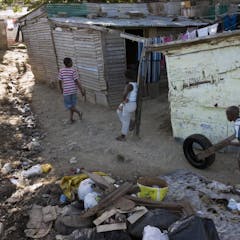
Artikel-artikel mengenai HIV/AIDS
Menampilkan 1 - 20 dari 309 artikel

The court covered itself in glory in the first 15 years, but its performance has been patchy since then, coinciding with Jacob Zuma’s presidency.

Eamon Flack’s production captures well – and with a lovely, light touch – the sense of fleeting memories that are, nevertheless, still available to us.

Haigh’s ghostly, dream-like setting offers a powerful remedy for an ageing generation of gay men coming to terms with the grief that pervaded their young lives.

Two-thirds of new HIV infections are among gay and bisexual men. Although cases have decreased among white men, they have stagnated among communities of color.

The film tells the story of Troy Lovegrove, a seven-year-old Australian boy who became HIV-infected during birth.

Science is getting closer to finding a cure for HIV.

Many people at heightened risk for HIV have never been tested. Those who have self-tested for HIV often don’t go on to receive care or change their sexual behavior.

Among young children, adolescents and adult women, anemia strikes 1 in 3 globally. Most cases are driven by dietary iron deficiency, red blood cell disorders and untreated tropical diseases.

When people living with HIV in Nigeria receive support from close friends, they are less likely to experience stigma and associated poor health outcomes.

Social enterprises need to be proactive in improving their internal processes and structures. They also need to share essential information.

In 1983, during the early days of the AIDS epidemic, the US Food and Drug Administration made the decision to ban gay men from donating blood. Now, 40 years later, it is dropping that rule.

As the government’s oldest consumer protection agency, the FDA has long butted up against drugmakers, activists and politicians. But undermining its work could be harmful to patient health and safety.

The US PEPFAR initiative has brought HIV medication to millions of people globally. Behind this progress are the activists that pressured politicians and companies to put patients over patents.

The next step in HIV prevention — long-acting injectable pre-exposure prophylaxis (PrEP) — is not yet available in Canada, a year after its approval in the U.S.

Prejudice and stigma can discourage the communities most affected by infectious diseases from seeking care. Inclusive public health messaging can prevent misinformation and guide the most vulnerable.

Dec. 1 marks World AIDS Day. Canada has the tools and means to end the epidemic. The question remains, are we up to the task?

Experts across the board have identified inequality as a major challenge to efforts to end AIDS.

Some countries, like Kenya, Uganda, South Africa, Zambia, and Nigeria, have been more proactive than others, but it is still hard for many to get PrEP.

Challenging myths about heterosexual white South African men, Prinsloo published four books of short stories in 12 years.

There has been a monumental policy shift in paying blood plasma donors in Canada.
